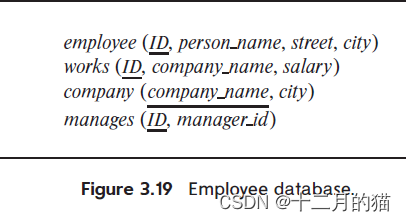
🌈 个人主页:十二月的猫-CSDN博客
🔥 系列专栏: 🏀数据库💪🏻 十二月的寒冬阻挡不了春天的脚步,十二点的黑夜遮蔽不住黎明的曙光
目录
前言
创建语句
创建表
创建视图
创建索引
插入语句
一次插入一条
一次插入多条
删除语句
修改语句
修改表结构
修改表格内容
查询语句
分类一:没有任何
分类二:至少有一个
分类三:满足条件一同时满足条件二但不满足条件三
分类五:模糊查询%的使用
分类五:间接关系(祖孙关系、间接先行课关系)
分类六:找出所有
分类七:存在重复项只记录一次(学生多次考试只取最高成绩)
分类八:存在具体数值要求+分组处理
分类九:超过所有
分类十:聚集函数嵌套的转化方法
分类十一:带条件更新
分类十二: 同表格不同角色匹配问题
总结
前言
数据库的操作无非就是增、删、改、查+创建
接下来,我将从以上五个角度来对SQL精选题进行分类,并总结相应解法
创建语句
数据库中创建主要包括:创建表、创建视图、创建索引、创建用户
创建的方式有:直接创建(直接指定创建内容)、间接创建(利用已有视图或表创建)
创建表
直接创建:
create table table1(sid char(12) not null,name varchar(10) not null,age int,birthday date,credit numeric(4,1)primary key(sid)foreign key(name) references student_name(name)
);先设定属性;再设定主键、外键等键值
间接创建:
create table table1 as
select sid,cid,score
from student
where sid='202100202052'两者比较:
直接创建:需要用小括号确定表结构范围(注意逗号、分号、括号)
间接创建:需要用as,但是会根据查询结果直接创建,不需要用()确定范围(啥也没有)
创建视图
视图的创建使用as间接创建,因为视图并不实际存储于数据库中,所以是基于已有表进行的
直接创建:
视图不能直接定义创建。因为视图并不存储在数据库中,而是基于已有表进行的创建
间接创建:
create view test3 as
select sid,cid,pub.course_name,score
from pub.student natural join pub.student_course natural join pub.course
where pub.student_name='李龙'两者比较:
视图的创建只能用间接创建法:利用as、不用加()限制范围
创建索引
索引的创建没有直接创建和间接创建的说法,索引只能定义创建,不能根据已有索引创建
create index index1 on student(sid,name)插入语句
插入语句分为:一次插入一条记录、一次插入多条记录两种类型
一次插入一条
insert into student values(202100202052,'李华',to_date('19950303 101010','yyyymmdd hh24miss'))一次插入多条
insert allinto test1_course values('300002','数据库','300001',2.5)into test1_course values('300001','数据结构',null,2)
select * from dual两者比较:
1、insert into
2、insert all into
3、date类型的插入利用to_data('20080715 101010‘,‘yyyymmdd hh24miss’)
删除语句
1、删除语句和插入语句的格式是相对应的
2、本部分的精选题重点在于各种全新的语句用法(不仅仅限于and、from、where等一般语句)
总结如下:
- regexp_like(sid,'^[0-9]+$')
- where score between 0 and 100
- length(sid)
- like '% %'
- where 后面跟(cid,tid)这种整体匹配语句
删除语句对应的是插入语句(一个是增一个删),因此两者的语法也类似。insert into和delete from相匹配
题目一:
删除表中的学号不全是数字的那些错误数据,学号应该是数字组成,不能够包含字母空格等非数字字符。方法之一:用substr函数,例如Substr(sid,1,1)返回学号的第一位,判断是否是数字。
delete from test3_01
where sid not in(select sidfrom test3_01where regexp_like(sid, '^[0-9]+$'))题目二:
删除表中的性别有错误的那些错误数据(性别只能够是“男”、“女”或者空值)。
delete from test3_03
where sex <> '男' and sex <> '女' and sex is not null题目三:
删除表中的院系名称有空格的、院系名称为空值或者院系名称小于3个字的那些错误数据。
delete from test3_04
where dname like '% %' or
dname is null or
length(dname) < 3题目四:
删除其中的错误数据,错误指如下情况:课程号和教师编号在教师授课表pub.teacher_course中不同时存在的,即没有该教师教该课程;
delete from test3_08
where (cid, tid) not in(select cid, tidfrom pub.teacher_course
)题目五:
删除其中的错误数据,错误指如下情况:成绩数据有错误(需要先找到成绩里面的错误)。
delete from test3_09
where score not between 0 and 100修改语句
在创建数据库表格并往表格内插入数据后,我们可能还需要对表格进行修改,因此修改语句也是必要的。修改语句包括:修改表结构、修改表格内容
修改表结构
alter table test4_02
add avg_score numeric(3,1)alter table test4_02
drop column avg_score 修改表格内容
update test4_01 Sset sum_score=(select sum(score)from pub.student_course Twhere S.sid=T.sid)update test4_07
set sex= replace( sex,'性','')update test4_10
set age=(select (2012-extract (year from birthday))from pub.student_42where test4_10.sid=sid
)
where test4_10.age is null;两者联系及感悟:
1、只有修改表结构和创建表结构时需要指定table和view
2、修改表格内容时用update以及set函数
3、replace函数常用来update不规范数据
4、extract函数用来提取date类型数据中的year、month、day都可以
重点来啦!!!数据库SQL语言中最难的部分就是查询。数据库查询大约占数据库语言使用的80%(李晖老师说的),所以查询语句写的好/不好对整体数据库性能的影响是很大的

查询语句
编写语句的思考流程:
1、确定要查询的变量
2、根据要查询的变量确定要查询的关系表(哪几个表、是否要自然连接处理等)
3、写查询的条件(最难的部分)
分类一:没有任何
没有任何=完全否定=全集-只要有一个在里面
使用minus实现
找出至少选修了学号为“200900130417”的学生所选修的一门课的学生的学号、姓名(不包含这名同学)。
select sid,name
from pub.student
where sid in((select distinct sidfrom pub.student_coursewhere cid in (select cidfrom pub.student_coursewhere sid='200900130417'))minus(select sidfrom pub.studentwhere sid='200900130417')
)分类二:至少有一个
in:或关系,只要有一个就是满足的
至少有一个=只要一个就满足=或关系
找出至少选修了一门其先行课程号为“300002”号课程的学生的学号、姓名。
select sid, namefrom pub.studentwhere sid in(select sidfrom pub.student_coursewhere cid in ( select cidfrom pub.student_coursewhere pcid='300002')
)分类三:满足条件一同时满足条件二但不满足条件三
满足多个条件/不满足多个条件的处理:
1、对于关系集合用minus、intersect来求交并集;
2、对于在where查询条件后的用and、or等来处理
3、一个属性上多条件——》交并集(minus、intersect);多个属性上多条件(and、or)
找出选修了“操作系统”并且也选修了“数据结构”,但是没有选修“程序设计语言”的学生的学号、姓名。
select sid,namefrom pub.studentwhere sid in((select sidfrom pub.student_coursewhere cid=(select cidfrom pub.coursewhere name='操作系统'))intersect(select sidfrom pub.student_coursewhere cid=(select cidfrom pub.coursewhere name='数据结构'))minus(select sidfrom pub.student_coursewhere cid=(select cidfrom pub.coursewhere name='程序设计语言')))查询2010级、计算机科学与技术学院、操作系统的学生成绩表,内容有学号、姓名、成绩。
select sid,name,scorefrom pub.student_course natural join pub.studentwhere class='2010' and dname='计算机科学与技术学院' and cid=(select cidfrom pub.coursewhere name='操作系统')分类五:模糊查询%的使用
%:就是模糊查询;模糊查询与like以及not like绑定使用
条件字符串部分限制、部分自由
查询所有不姓张、不姓李、也不姓王的学生的学号sid、姓名name
select sid,name
from pub.student
where name not like '张%'
and name not like '李%'
and name not like '王%'分类五:间接关系(祖孙关系、间接先行课关系)
两种方法:
1、利用笛卡尔积实现
2、利用嵌套结构实现
比较和联系:
1、笛卡尔积A*B实现本质就是让A中的每一个元组和B中的每一个元组比较
2、嵌套结构先找出B的所有元组,利用in来将A中的每个元组和B的每个元组比较比较
找出有间接先行课的所有课程的课程号、课程名称。
select cid ,name
from pub.course
where fcid in (select cidfrom pub.coursewhere fcid is not NULL
)已知所有的父子关系fstable表,找出里面的爷孙关系的名字
select s1.father,s2.son
from fstable s1,fstable s2
where s1.son=s2.father分类六:找出所有
所有关系:用除运算实现,除运算找出的就是集合和其子集的关系(所有关系)
在SQL中不能使用除运算,改为用not exists实现
找出选修了所有课程的学生的学号、姓名。
select sid,name
from pub.student
where not exists((select cidfrom pub.course)minus(select cidfrom pub.student_coursewhere pub.student_course.sid=pub.student.sid)
)分类七:存在重复项只记录一次(学生多次考试只取最高成绩)
表格1存在重复项,想要计算没有重复项参与的表格1中的数据
1、找中介人:找到一个不存在重复项的表格2,利用表格2实现对表格1的剔除工作。此时,表格2作用为:剔除者、观察者;表格1作用为:实际要找寻的资料原件
使用update语句,利用pub.student_course、pub.course,统计 “总学分”;
(这是需要注意:成绩及格才能够计算所得学分,一门课多个成绩都及格只计一次学分)
update test4_03 Sset sum_credit=(select sum(credit)from pub.coursewhere cid in(select distinct cidfrom pub.student_course SCwhere S.sid=SC.sidand SC.score>=60))分类八:存在具体数值要求+分组处理
分组处理:需要用表中的某一个元素将其他信息聚合起来(出版社/会员)
对于每个出版商,找出每个借了该出版商五本书以上的会员的编号和姓名

select memb_no,name
from member m
where memb_no in(select memb_nofrom borrowed bw,book bkwhere bw.isbn=bk.isbngroup by publisher,memb_nohaving (count(*)>5)
)having:后面跟的应该是bool类型的表达式结果,having和where一样是筛选条件
having的作用范围:分组后的组内
分类九:超过所有
超过所有=超过最大值——》利用max来求解最大值
找出所有收入超过 "小型银行公司 "每个员工的员工 ID
select id
from work
where salary >
(select max(salary)from workswhere company_name='Small Bank Corporation'
)假设一个公司可以在好几个城市有分部。找出位于“Small Bank Corporation”所在城市的所有公司(company_name是主键,所以一家公司只能在一个城市)
Select company_name
From Company
Where city in (select cityFrom companyWhere company_name = 'Small Bank Corporation'
)上题的难度在于对题目的理解:位于“Small Bank Corporation”所在城市。
1、找出“Small Bank Corporation”的城市
2、利用in来实现位于动作
分类十:聚集函数嵌套的转化方法
有时候我们会遇到需要使用两个聚集函数的情况,但是在一个关系中聚集函数是不能够嵌套使用的,因此需要用别的方法来代替聚集函数嵌套使用
常见的嵌套场景:count+max(求count元组数中的最大值)
找出雇员最多的公司名称(或公司名称、在最多员工数相同的情况下)的公司名称
1、首先需要求解每个公司的雇员——需要count聚集函数
2、求解雇员数最大的公司——需要max函数对count结果使用
转化:雇员最多=雇员比最多的还多(count+max)=雇员比所有的都多(count+all),成功避开聚集函数的嵌套
select company_name
from works
group by company_name
having count(id)>=all(select count(id)from worksgroup by company_name
)找出工资总额最小的公司
select company_name
from works
group by company_name
having (sum(salary)<all(select sum(salary)from worksgroup by company_name)
)分类十一:带条件更新
存在一类更新是带有条件的,不同条件下的元组更新的方式也不同
更新无非增加/减少
为了防止非法更新两次:需要满足增加时先加大的,减少时先减少的
给 "第一银行公司 "的每位经理加薪 10%,除非其工资超过 100000 美元。在这种情况下,只加薪 3%(这两个update的顺序不可以更换)(增加时先加大的,减少时先减少的;防止有的记录被操作两次)
update works as T
set T.salary=t.salary*1.03
where works.id in (select idfrom manages
)
and salary>100000
and company_name='First Bank Corporation'update works as T
set T.salary=t.salary*1.1
where works.id in (select idfrom manages
)
and salary<100000
and company_name='First Bank Corporation'分类十二: 同表格不同角色匹配问题
匹配问题=比较是否相等=比较问题
比较只能发生在两个关系模式之间
1、此时两个角色进行比较,两个角色对应的表格是同一个
2、因此拿相同关系模式当作两个不同的关系模式做笛卡尔积,再比较结果
3、笛卡尔后判断相应的属性是否符合要求
查找与其经理住在同一城市同一条街上的每位员工的 ID 和姓名

select e.id,e.person_name
from employee e natural join managers m,employee e2
where m.manager_id=e2.id and e.city=e2.city and e.street=e2.street简化写法:
SELECT e.id, e.person_name
FROM employee e
JOIN managers m ON e.id = m.id
JOIN employee e2 ON m.manager_id = e2.id
WHERE e.city = e2.city AND e.street = e2.street;
总结
本文的所有知识点、图片均来自《数据库系统概念》(黑宝书)、山东大学李晖老师PPT。不可用于商业用途转发。


基于vite+vue3+element-plus项目创建)

—— 卷积神经网络CNN)













)

